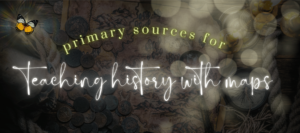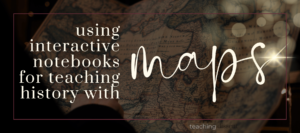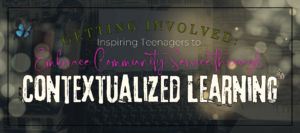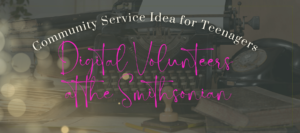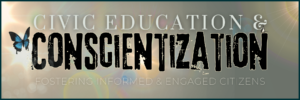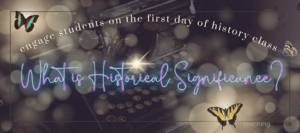Here is a unique community service idea for students who aren’t able to secure transportation anywhere outside of school: digital volunteering! No really, its a thing. There are actually so many different options, especially after the pandemic. I required students to do community service every quarter along with a reflective essay as part of our civics curriculum. Through the years, I was able to integrate the Social Studies and Language Arts standards into a cohesive project, and found it was most effective when done through a foundation of contextualization.
Anyway. This post is for practical advice!
Here is an example of virtual community service for students that is actually worth considering:
Smithsonian Digital Volunteers project
The overarching purpose of the Smithsonian Digital Volunteers project is to engage the public in the transcription and digitization of historical documents, manuscripts, and other materials from the Smithsonian Institution’s vast collections. Perfect for a community service idea. The Smithsonian Digital Volunteers: Transcription Center harnesses the power of volunteers, even teenager volunteers, for the efficient transcription of vast amounts of material that would be challenging for a small team to complete. The community service idea actually plays a crucial role in democratizing access to historical and cultural resources while actively involving the public in the Smithsonian’s mission to increase and diffuse knowledge. Their crowdsourcing approach accelerates the digitization process, and offers teenagers a unique and valuable opportunity to learn, grow, and make a positive impact on their community and the broader world while contributing to the preservation of cultural heritage.
This community service idea serves several important objectives:
- Preservation of Cultural Heritage: By transcribing and digitizing historical materials, the project helps preserve and make accessible important cultural and historical artifacts that might otherwise deteriorate over time. This ensures that future generations can study and appreciate these materials.
- Accessibility & Collaboration: Transcribing handwritten or hard-to-read documents into digital text makes them more accessible to researchers, students, and the general public. It helps break down barriers to accessing historical knowledge. Additionally, it encourages collaboration among volunteers, scholars, and institutions, fostering a sense of community and shared responsibility for preserving and sharing cultural heritage.
- Research and Scholarship: The transcribed materials become valuable resources for researchers, scholars, and educators. These documents can be used in academic research, exhibitions, and educational programs.
- Community Engagement: As a community service idea, the project fosters community engagement by allowing volunteers, including teenagers and the general public, to actively participate in preserving and sharing history. It’s an opportunity for people to connect with the Smithsonian’s mission.
- Interdisciplinary Insights: Transcription projects cover a wide range of topics and materials, providing insights into various aspects of culture, science, history, and art. This interdisciplinary approach enriches the understanding of the Smithsonian’s diverse collections.
While it would be good for all of us at all our ages to contribute to this project, it benefits teenagers specifically in the following ways:
Community service idea benefits for teenagers
Educational Opportunities:
- Skill Development: Through community service, teenagers can enhance their research, transcription, and digital literacy skills, which are valuable for both current and future academic and professional pursuits.
- Digital Literacy: Teens improve their digital literacy skills by working with online platforms and digital tools, which are increasingly important in today’s world.
- Historical and Cultural Knowledge: This community service idea offers a valuable learning experience for teenagers in particular as they develop a sense of contributing to a greater purpose. By engaging firsthand with primary documents, students are able to gain a deeper understanding of history, culture, and other subject areas from the diverse Smithsonian collections.
College and Career Exploration:
- Resume Building: This community service idea offers a unique addition to a student’s resume, demonstrating their commitment to community service, education, and an interest in cultural preservation. Having community service experience at an institution like the Smithsonian can make college applications stand out for students pursuing degrees in related fields.
- Widening scope of awareness: For some students, this could be the first time this kind of world, this kind of work, is made accessible. Participation in these projects can provide insights into potential career paths in fields such as history, museum studies, archiving, and digital preservation.
- Confidence boost: Successfully transcribing historical documents while making real contributions to the Smithsonian’s mission can go a long way in boosting teenagers’ confidence in their own abilities beyond what they may have been told they are capable of.
Community Engagement:
- Networking: They may have the opportunity to connect with professionals and like-minded individuals who share their interests. Additionally, volunteering at a prestigious institution like the Smithsonian gives teenagers a sense of purpose and accomplishment as they actively contribute to preserving cultural heritage.
- Civic Responsibility: Engaging in community service serves to instil a sense of civic responsibility, teaching teenagers about the importance of giving back to their communities by preserving shared history. Who knows how their contributions to making information accessible to a wider audience will help someone else in the future!
How students can volunteer at the Smithsonian
Teenagers who want to do their community service at the Smithsonian Transcription Center may follow these general steps. Please note that policies and requirements may change, so it’s a good idea to visit the official website or contact the Smithsonian directly for the most up-to-date information:
- Students must 14 years or older, and will need an email.
- Visit the Transcription Center Website: Go to the Smithsonian Digital Volunteers: Transcription Center website.
- Browse Projects: Explore the various transcription projects available on the website. These projects may involve transcribing handwritten documents, cataloging information, or other tasks related to preserving historical records.
- Create an Account: To get started, students will need to create an account on the Transcription Center’s website. They may need to provide some personal information, and if they are under 18, may require parental consent.
- Choose a Project: Once students have an account, browse the available projects and choose one that interests them. Each project will have a description, and students can select the one that aligns with their interests and skills.
- Complete Transcriptions: Follow the guidelines provided by the Transcription Center for the specific project they’ve chosen. This often involves transcribing text from historical documents or records. They can do this online.
- Track Progress: The platforms allows students to track their progress and see how much they’ve contributed to a particular project or to the Smithsonian’s overall efforts.…
- Submit Work: After transcribing a section or completing a task, submit their work through the website. Their contributions will be reviewed and verified by administrators.
Remember that policies and requirements may change over time, so it’s essential to refer to the Smithsonian’s official website or contact them directly for the most current information on volunteering opportunities for teenagers at the Smithsonian Digital Volunteers: Transcription Center.
Good luck! I hope this digital community service for teenagers idea will help inspire your students!
Community Service for Teenagers
Community service for teenagers is the perfect opportunity to teach about civic responsibility as envisioned by the Founders as a cornerstone of constitutional democracy. This community service for teenagers project and scaffolded reflection essay provides middle and high school students the opportunity to be at the center of their own learning by putting theory to action: students will develop their own informed opinions on the role of citizens in a democracy through active civic engagement and reflection throughout the school year.




